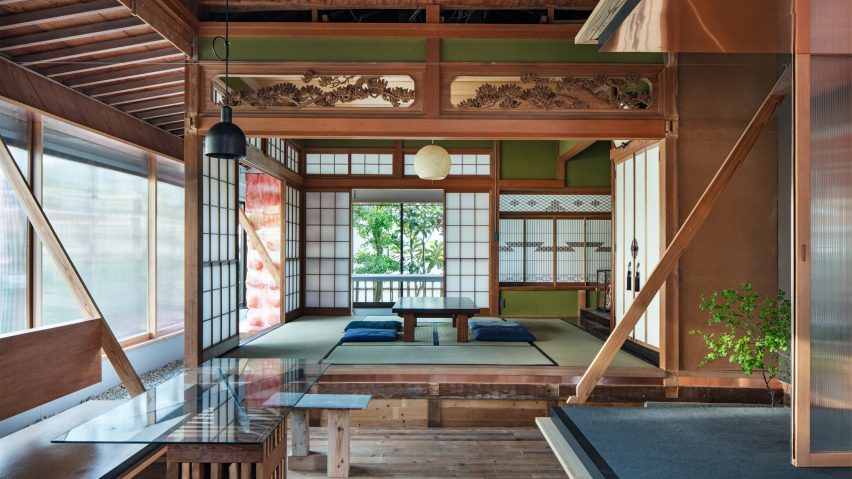Architecture studio NYAWA has restored and updated a traditional timber home in Toyama, Japan, to create a pared-back holiday home where visitors can "feel the passage of time".
The home's Tokyo-based owner tasked the studio with creating a holiday rental that would "incorporate the local climate and culture", while also updating its structure to be earthquake resilient.
Typical to many historical dwellings in the region, the building is organised around a large gathering space known as a hiroma, wrapped by sliding doors that allow it to be open to a covered porch or engawa.
Throughout the ground floor, the original wooden structure, including decorative carvings, has been restored and reinforced, with the addition of bench-like seating and glass partitions to maximise views and sight-lines.
A variety of floor finishes demarcate different areas in this open space, with wood and tatami floors in the seating areas, concrete in the kitchen space and areas of pebbles in between.
Looking to blend these more traditional spaces with modern amenities, the upper-storey bedrooms have been given new walls, floors and ceilings, painted white with built-in storage.
"Retaining and showing the old wooden structure, including the roofing system, gives a sense of the long passage of time in this house," NYAWA founder Yoh Miyashita told Dezeen.
"[However], we thought that simply leaving the old things and cleaning them up would not complete what is comfortable for people today," he added.
For new surfaces in the living areas, NYAWA used materials that were both traditional to the area and would also visibly weather to create a dialogue with the existing structure.
Silk curtains work with the sliding doors to allow the connection to the outdoors to be mediated, while a copper-clad ceiling in the koagari (raised seating area) bounces light around the space.
"In the newly finished areas, we consciously used materials that reflect light; this is because cloudy weather is common in Hokuriku, and reflection is important for a bright interior," Miyashita told Dezeen.
"Copper is a traditional material in this region, and we thought it was particularly appropriate," he added.
Alongside traditional shoji screens, corrugated polycarbonate screens have also been used to provide varying degrees of light and privacy.
The landscaped garden that surrounds the home was left largely untouched apart from improvements to drainage, and provides a backdrop to the living areas as well as a visual buffer from the street.
Elsewhere in Japan, Studio AMB also updated a traditional wooden home to create a guesthouse in Misumi, with a communal ground floor space that is open to the elements.
The photography is by Kenta Hasegawa.
Project credits:
Lead architect: Wataru Maruyama
Architect and environmental designer: Yoh Miyashita
Architect: Daisuke Kobayashi
Structural designer: Junnosuke Takiguchi

